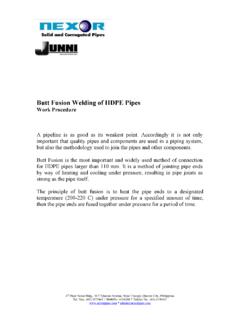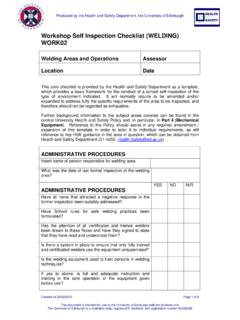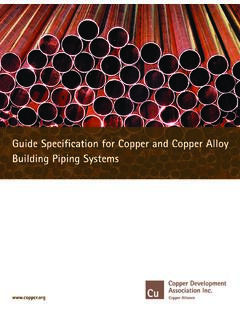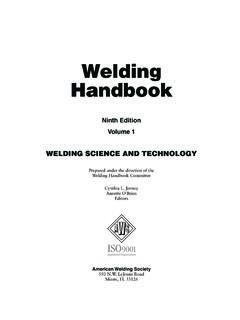Transcription of Butt Fusion Welding of HDPE Pipes
1 4th Floor Nexor Bldg., 1677 Quezon Avenue, West Triangle, Quezon City, Philippines Tel. Nos.: (02) 9275441 / 3868056 / 4104288 * Telefax No.: (02) 4150143 * Butt Fusion Welding of HDPE Pipes Work Procedure A pipeline is as good as its weakest point. Accordingly it is not only important that quality Pipes and components are used in a piping system, but also the methodology used to join the Pipes and other components.
2 Butt Fusion is the most important and widely used method of connection for HDPE Pipes larger than 110 mm. It is a method of jointing pipe ends by way of heating and cooling under pressure, resulting in pipe joints as strong as the pipe itself. The principle of butt Fusion is to heat the pipe ends to a designated temperature (200;220 C) under pressure for a specified amount of time, then the pipe ends are fused together under pressure for a period of time. 4th Floor Nexor Bldg., 1677 Quezon Avenue, West Triangle, Quezon City, Philippines Tel. Nos.: (02) 9275441 / 3868056 / 4104288 * Telefax No.: (02) 4150143 * STEP WORKING PROCEDURE 1.
3 Preparation of Welding : before you start the operation, it is important to prepare the work area. Select the operation area that is suitable for the work. Install the protection tent or other equipment to protect the Welding zone against rain, sunshine or bad weather (if required) Set up the Welding machine with all the accessories according to the Welding pipe size. Check if the machine is functioning. All of the problems or missing parts must be fixed prior to the start of the Welding operation. 2. Insert two Pipes ends on both side of the machine clamps, protrude approx. 3;5 cm. from each shell side, clamping and adjust the pipe or piping part, the surfaces to be welded should be parallel to each other. Adjust the alignment of pipe line by tightening or losing bronze nuts on the top aluminum clamps.
4 Secure longitudinal movement of the parts to be welded by taking appropriate measures. Clean outside and inside pipe surface. 3. Insert the facing tool or trimmer between the two pipe ends into the lock position on the Welding machine. 4th Floor Nexor Bldg., 1677 Quezon Avenue, West Triangle, Quezon City, Philippines Tel. Nos.: (02) 9275441 / 3868056 / 4104288 * Telefax No.: (02) 4150143 * 4. Start the facing tool or trimmer by turning on the control switch. Slowly approach the pipe ends towards the facing tool or trimmer by controlling the directional valve on hydraulic control unit while keeping control pressure a little higher. The cutter will cut the surface of both pipe ends making them clean, plane and parallel.
5 5. When the pipe ends had been trimmed squarely and with an even thickness, slowly decrease the pressure before switching off. Remove the facing tool or trimmer from Welding machine to the support frame and clear the facing scraps from pipe ends. Inspect the ends, they must be clean and plane; otherwise repeat the step 3 5 again. During the clearing and inspection, avoid any contact with the surface of pipe ends. 6. Recheck the alignment of the pipeline by bringing the pipe ends closely together and measure the actual tolerance. The misalignment value between both pipe ends should not be more than 10% of the pipe wall thickness. The gap width is the allowance between the treated pipe end, should not exceed the value shown on Table 2.
6 If they are not in the control tolerance, then repeat the steps 2;5 again. 4th Floor Nexor Bldg., 1677 Quezon Avenue, West Triangle, Quezon City, Philippines Tel. Nos.: (02) 9275441 / 3868056 / 4104288 * Telefax No.: (02) 4150143 * 7. During the alignment checking in step 6, the welder team must measure the force or pulling pressure (drag pressure) by looking and recording the data found at the pressure indicator device The pressure must be created to pull the whole work piece moving in between Welding process. The drag pressure is the additional value that must be added up to the alignment pressure (P1) and joining pressure (P3) from calculation or machine pressure data for each operation area and every Welding joint.
7 8. The Welding team to prepare the Welding parameter by calculating using the recommended values according to Table 1, Table 3 or machine data for the Welding operation control. Check the heating plate temperature on the setting range according to step 1; cleaning both heating plate side with cleaning agent and insert its back to support while waiting for Welding operation to start. 9. Bring the pipe ends apart, to clean both pipe ends using coat with an ethyl;alcohol or other suitable cleaning agent and avoided any contact to the surface after cleaning. Repeat the cleaning process, if necessary. 10. To start with the Welding process, begin with the alignment stage by inserting the heating plate between the two pipe ends, moving both pipe ends close together until contact with the heating plate.
8 Start the build up pressure to the alignment pressure level (P1 + drag pressure), maintain the pressure until there are Welding seam appear. 11. In this stage, the uniform bead should had been created between the heating plate throughout the whole circumference of both pipe ends. The pressure must be maintained until the bead height according to the calculation value in table 1 by visual inspection. Continue to the heating;up stage by reducing pressure and maintaining the heating;up pressure level (P2) along heating;up time (T2). 4th Floor Nexor Bldg., 1677 Quezon Avenue, West Triangle, Quezon City, Philippines Tel. Nos.: (02) 9275441 / 3868056 / 4104288 * Telefax No.: (02) 4150143 * 12 Open both pipe ends, carefully remove the heating plate without touching the melted area and see to it that the removing time should not be longer than the changeover time (T3), insert heating plate to the support.
9 13 Immediately increase pressure up to the joining pressure level (P3 + drag pressure) within the joining pressure built;up time (T4) Uniform beads must be created throughout the whole circumference of the pipe joints. Maintain or Keep the joining pressure constant throughout the cooling time (T5) or until the Welding joint cools down. Avoid forced cooling down by applying water. 14. Remove the clamps after the cooling stage is complete. Welding bead of each jointing has to be visually inspected and measured based on the following: o Both ends should be almost equal in dimension o The bead surface should be smooth and do not shine. o Bead width must be according to the limit dimension Possible differences in the formation of the beads may be justified by different behavior of the joined materials.
10 15. All the Welding information must be recorded into the data logger, log sheet or Welding protocol form. 4th Floor Nexor Bldg., 1677 Quezon Avenue, West Triangle, Quezon City, Philippines Tel. Nos.: (02) 9275441 / 3868056 / 4104288 * Telefax No.: (02) 4150143 * Table1. Welding ParamTable1. Welding ParamTable1. Welding ParamTable1. Welding Parameter and control for calculation method and eter and control for calculation method and eter and control for calculation method and eter and control for calculation method and recommended values to be usedrecommended values to be usedrecommended values to be usedrecommended values to be used DescriptionDescriptionDescriptionDescrip tion ParameterParameterParameterParameter CalculationCalculationCalculationCalcula tion RecommendRecommendRecommendRecommended Valuesed Valuesed Valuesed Values 1.










